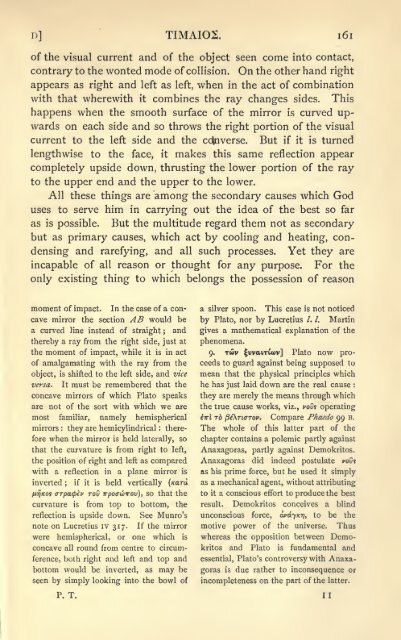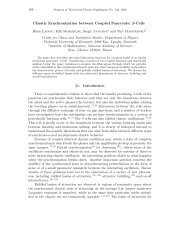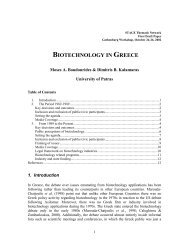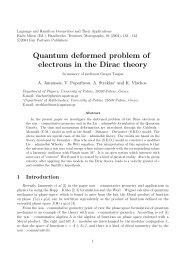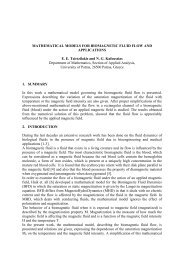Create successful ePaper yourself
Turn your PDF publications into a flip-book with our unique Google optimized e-Paper software.
TIMAIO2. 161<br />
<strong>of</strong> the visual current and <strong>of</strong> the object seen come into contact,<br />
the other hand right<br />
contrary to the wonted mode <strong>of</strong> collision. On<br />
appears as right and left as left, when in the act <strong>of</strong> combination<br />
with that wherewith it combines the ray changes sides. This<br />
happens when the smooth surface <strong>of</strong> the mirror is curved upwards<br />
on each side and so throws the right portion <strong>of</strong> the visual<br />
current to the left side and the ccfoiverse. But if it is turned<br />
lengthwise to the face, it makes this same reflection appear<br />
completely upside down, thrusting the lower portion <strong>of</strong> the ray<br />
to the upper end and the upper to the lower.<br />
All these things are among the secondary causes which God<br />
uses to serve him in carrying out the idea <strong>of</strong> the best so far<br />
as is possible. But the multitude regard them not as secondary<br />
but as primary causes, which act by cooling and heating, condensing<br />
and rarefying, and all such processes. Yet they are<br />
incapable <strong>of</strong> all reason or thought for any purpose. For the<br />
only existing thing to which belongs the possession <strong>of</strong> reason<br />
moment <strong>of</strong> impact. In the case <strong>of</strong> a concave<br />
mirror the section AB would be<br />
a curved line instead <strong>of</strong> straight ;<br />
and<br />
thereby a ray from the right side, just at<br />
the moment <strong>of</strong> impact, while it is in act<br />
<strong>of</strong> amalgamating with the ray from the<br />
object, is shifted to the left side, and vice<br />
versa- It must be remembered that the<br />
concave mirrors <strong>of</strong> which <strong>Plato</strong> speaks<br />
are not <strong>of</strong> the sort with which we are<br />
most familiar, namely hemispherical<br />
mirrors :<br />
they are hemicylindrical : therefore<br />
when the mirror is held laterally, so<br />
that the curvature is from right to left,<br />
the position <strong>of</strong> right and left as compared<br />
with a reflection in a plane mirror is<br />
inverted ; if it is held vertically (Kara.<br />
pfJKos TOV irpocrwirov), so that the<br />
curvature is from top to bottom, the<br />
reflection is upside down. See Munro's<br />
note on Lucretius iv 317. If the mirror<br />
were hemispherical, or one which is<br />
concave all round from centre to circumference,<br />
both right and left and top and<br />
bottom would be inverted, as may be<br />
seen by simply looking into the bowl <strong>of</strong><br />
P. T.<br />
a silver spoon. This case is not noticed<br />
by <strong>Plato</strong>, nor by Lucretius /. /. Martin<br />
gives a mathematical explanation <strong>of</strong> the<br />
phenomena.<br />
9. TWV jjvvaiTCwv] <strong>Plato</strong> now proceeds<br />
to guard against being supposed to<br />
mean that the physical principles which<br />
he has just laid down are the real cause :<br />
they are merely the means through which<br />
the true cause works, viz., poCs operating<br />
^?ri rb (3\Tiffrov. Compare Phaedo 99 B.<br />
<strong>The</strong> whole <strong>of</strong> this latter part <strong>of</strong> the<br />
chapter contains a polemic partly against<br />
Anaxagoras, partly against Demokritos.<br />
Anaxagoras did indeed postulate vovt<br />
as his prime force, but he used it<br />
simply<br />
as a mechanical agent, without attributing<br />
to it a conscious effort to produce the best<br />
result. Demokritos conceives a blind<br />
unconscious force, avdyKi), to be the<br />
motive power <strong>of</strong> the universe. Thus<br />
whereas the opposition between Demokritos<br />
and <strong>Plato</strong> is fundamental and<br />
essential, <strong>Plato</strong>'s controversy with Anaxagoras<br />
is due rather to inconsequence or<br />
incompleteness on the part <strong>of</strong> the latter.<br />
II


